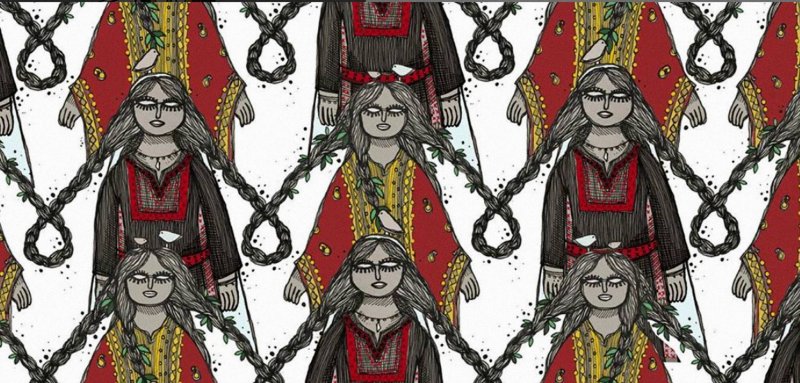Typically, a caricature is meant to portray economic, social, and political phenomena within a society, taking on important issues from a cynical or comic standpoint. However, in the Arabian Gulf countries, many topics are considered red lines that cannot be crossed, specifically those of political nature. I it is acceptable for the Gulf region’s caricaturists to tackle political issues in China, Japan, Europe or the United States, but when it comes to causes in their own countries or those surrounding them, it is basically forbidden. When facing such a fact, the main question that comes to mind is: why?
Red Lines
The laws, customs, and policies of media corporations are what control political caricatures, “There can be no political topics without legal ramifications here, unless the targeted subject matches the agenda of the official state institution in the country. This is not just strictly limited to political topics. There are countless boundaries and red lines, some less defined, that are closely safeguarded by official and civil authorities alike. Thus, a caricaturist’s work must remain within the scope of his limitations and as much as his ‘propriety’ allows, as well as be prepared to exercise it without ruining his career,” this is how Bahraini caricaturist Khaled al-Hashimi described the situation in the Gulf to Rasef22.
He adds, “Oftentimes these restrictions and taboos leave little legroom for critical illustrations, which don’t necessarily have to be political. These limitations come in response to the severity of the repercussions an artist may be subjected to when he/she crosses those lines. There are rigid mentalities, especially those of the strict religious variety that rule the social scene with tyranny and oppression as well as a complete lack of tolerance, that feed into despotism and the suppression of an artist’s freedom of expression.”
Al-Hashimi sees that Gulf societies are not very advanced when it comes to freedom of expression and artistic criticism, saying, “Perhaps they have witnessed a recent decline on this scale when compared to earlier years, and so while in the presence of local and regional political aspects, the caricature has mostly become timid and modest, as well as prejudiced towards state media corporations. All this comes along with strict publishing laws, that include unjust measures that could easily be turned against the artist to face repercussions.”
There are rigid mentalities, especially those of the strict religious variety that rule the social scene with tyranny and oppression as well as a complete lack of tolerance, that feed into despotism and the suppression of an artist’s freedom of expression
Meanwhile Kuwaiti caricaturist Bader Bin Ghaith discussed red lines with Raseef22, stating, “The red line is an illusionary line planted by society into the artist’s mindset, so that he constantly fears accountability and retribution. This illusionary line doesn’t exist, and each artist must overcome it with his own artistic creativity. Sometimes there are legislative acts that criminalize criticizing or depicting a certain figure or subject, but a clever artist can overcome this with creativity. Whereas when it comes to ethical and moral aspects, an artist should be aware that whatever art he is producing must be for the benefit of society, instead of to create a rift or wreak havoc. Most importantly, he must not deviate from the principles he personally believes in.”
On the other hand, Saudi caricaturist Maher Ashour indicates otherwise in his conversation with Raseef22, “Political caricature in particular does not align well with the emotional human nature of Arabs. Meanwhile, political subjects that can be covered include international affairs that correspond with the politics of the country the artist lives in. He can touch upon all international matters that have to do with both internal and external policies.”
Ashour believes that in the Arab nation “most Gulf and Arab caricaturists tackle what is accepted and what agrees with their country’s policies in their drawings, since they are aware that they could encounter prosecution, penalization, or even investigation if they sketch otherwise.”
On the other hand, Bahraini caricaturist Sarah al-Kaed thinks that the situation in the Gulf is complicated, elaborating to Raseef22 that, “The political caricature is directly connected to the overall political atmosphere, and here, an artist relies on guesswork. He could produce an artwork that could be understood in a different way, since there is system censorship as well as public censorship.”
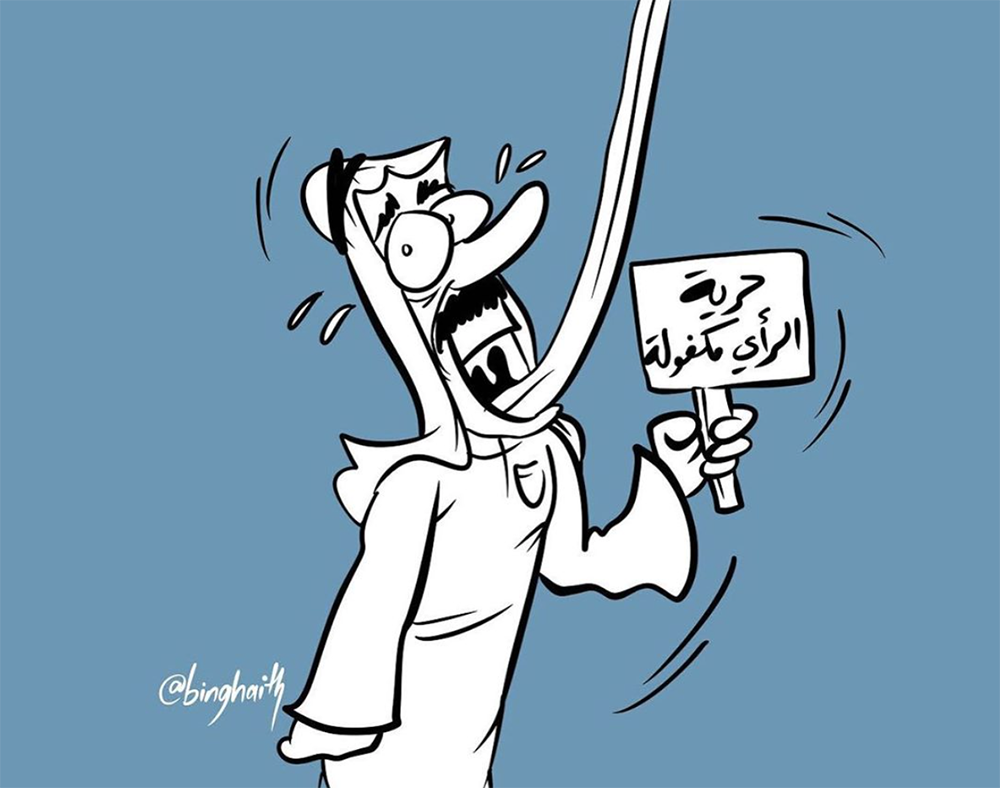
Normalizing Ties With Israel
Following the Gulf wave of normalizing relations with Israel, al-Kaed dedicated a number of artworks to criticize such a move in the clear and explicit stance, “No to normalization (tatbeea’),” even if it doesn’t align with the government’s policies. She says, “I cannot bear the thought. I was raised in a house that was very involved in the Palestinian cause, surrounded by photos of the Intifada and Mohammad al-Durra in school. Even the first ever caricature I drew was of the slaughtered Palestinian Samouni family (2009/2010). The Palestinian cause is not something that can be covered on occasions, rather it is an ongoing issue. Injustices are present and become more brutal by the day. Unfortunately, establishments continue to stoop lower and lower every day, until now we have reached normalizing relations [with Israel].”
She goes on to add, “I’m afraid of visual memory being erased, so I set out to create more. How much proof of the public’s refusal do official establishments need? In the future, people studying history will look back and I want them to see a clear stance from us. I dedicate these pieces of work to all the lives that were taken or displaced. The resounding ‘no’ against Israeli normalization deals must always be heard; we must never say ‘yes’ or tone down the issue. There remains much to offer the Palestinian cause on many different aspects no matter the cost.”
Sarah does not believe in absolute freedom, and there are some topics she does not tackle in her political artwork, saying, “I don’t draw sexual insinuations; I criticize Israel but not necessarily the Jewish faith; I sometimes criticize Muslim practices since I’m a Muslim myself. Self-censorship sometimes forces me to remove some artworks since they can be understood in a certain way. There are also social and religious boundaries that are applicable depending on the timing, story, and subject.”
“Typically, a caricature is meant to portray economic, social, and political phenomena within a society, taking on important issues from a cynical or comedic standpoint. However, in Gulf countries, many topics are considered red lines that cannot be crossed, specifically those of the political nature.”
For his part, Omani caricaturist Fahad al-Zadjali stresses that a caricaturist has a sizeable margin of freedom to work with, commenting, “Unlike a journalist that formulates a news story in a serious and objective manner, and in compliance with his newspaper’s policies, a caricaturist has a larger margin of freedom. He portrays an idea or issue in a cynical and less serious manner, which allows him to navigate taboos and boundaries, so to speak.”
Al-Zadjali also remarks, “Journalism in the Gulf, along with its regulations, needs a larger margin of freedom and to become more open, and whatever applies to journalism also applies to caricature, since it is one of the cornerstones of artistic journalism and a vital part of any newspaper. A caricaturist plays an important part in portraying his visualization over a certain topic, but in my opinion, his role is less intense and more flexible than that of a journalist. A caricaturist also has other ways to portray his ideas through social media sites that provide an outlet without much restriction.”
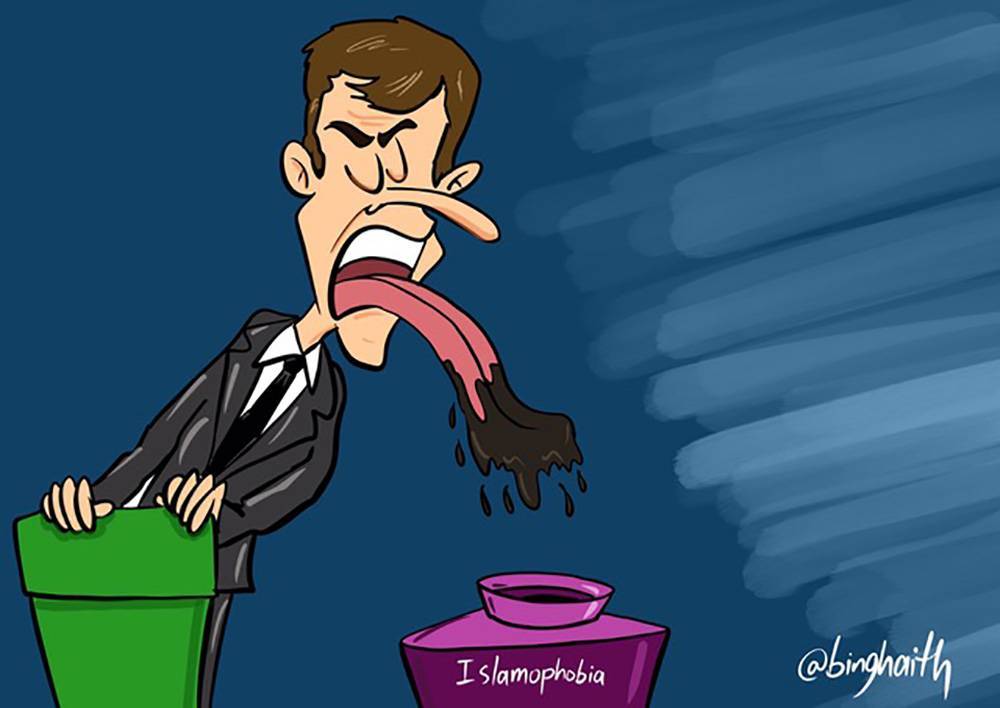
What Are The Major Topics?
Sectarian and ethnic conflicts, power struggles, poverty and corruption are general topics of which most Arab and Gulf countries suffer from; so, what is it that grabs the attention of Gulf caricaturists?
Bin Ghaith replies that he is always on the lookout for humanitarian topics or local matters that resemble international ones. He states, “Local political issues sometimes address different angles than what the main topic proposes or what the receiver is used to, therefore I always look for a new angle to take on in the world of politics.”
Al-Kaed offers, “I am interested in covering the in-depth topics of society. This is how I began and studying helped. I came to love caricature more with practice. I am intrigued by topics like the monarch, disputed areas, the dictatorship and its content public. Sketching clarifies things for me; the picture doesn’t necessarily need to be complete.”
Most Gulf and Arab caricaturists tackle what is accepted and what agrees with their country’s policies in their drawings; They are aware that they could encounter prosecution, penalization, or even investigation if they sketch otherwise
According to Al-Hashimi, topics that appeal to him are those that incite foolish behavior or political vanity when dealing with certain events. He comments, “Personally, I care for humanitarian topics that deal with people’s grief and concerns, far from narcissistic politics. I am especially provoked by attitudes that insult basic human rights specifically for the purpose of bolstering the power of a regime or individual. I tend to cover wide-ranging comprehensive topics, especially those of the humanitarian nature.”
He goes on to say, “There are countless political subjects to cover within our contradictory Arab world. Ultimately, it is the artist who portrays such topics depending on his viewpoint if he is unrestricted. However, if he was employed as a tool for a media institution, then his work would no doubt be publicity or advertisement for whatever political enterprise that employs him. There is nothing worse than hypocrisy and volatility in Arab politics.”
In turn, al-Zadjali points out that the political situation across the world is full of interloping events and issues that attract him to work on, such as “events that have left human suffering and crisis in its wake, namely the Palestinian cause. Of course, we must not forget humanitarian situations brought on by war and persecution in places such as Yemen, Libya Syria, and the Rohingya in Myanmar. In addition, the cold war between the United States and China on the one hand and Russia on the other.”
“There are countless political subjects to cover within our contradictory Arab world. Ultimately, it is the artist who portrays such topics depending on his viewpoint if he is unrestricted. However if he was employed as a tool for a media institution, then his work would no doubt be publicity or advertisement for whatever political enterprise that employs him.”
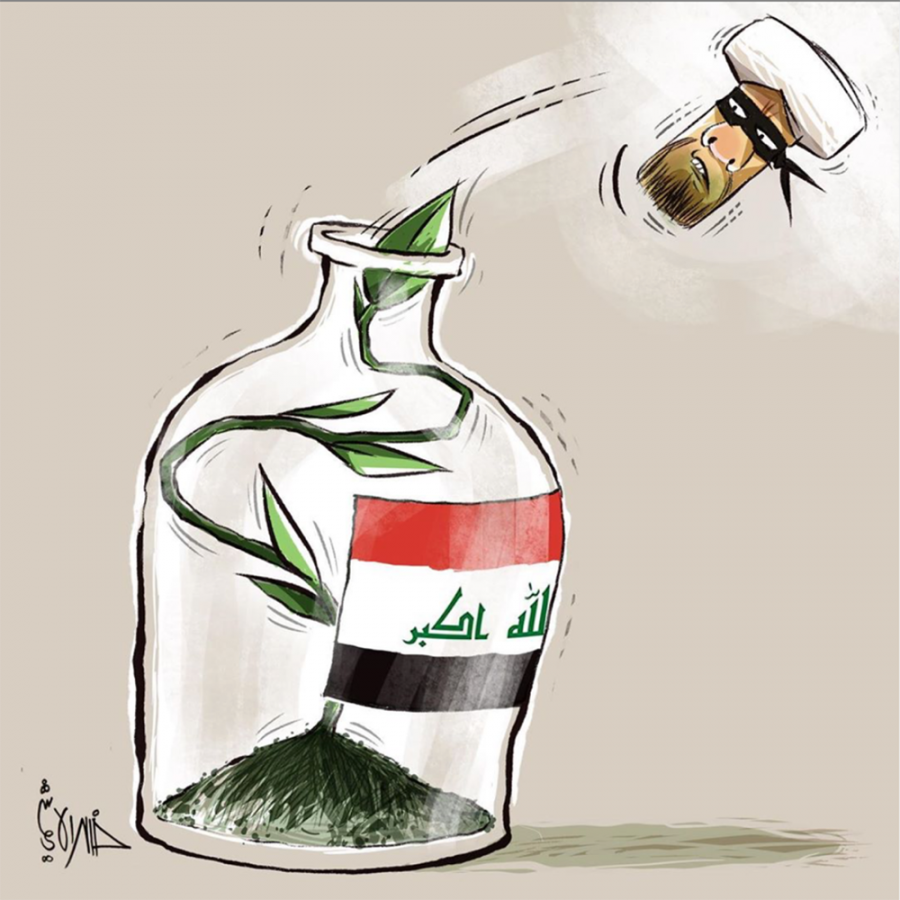
Meanwhile, Bahraini caricaturist Ali al-Bazzaz says, “In our countries, everything is either directly or indirectly interconnected with politics. So, whatever the topic being addressed through your drawing, it touches upon politics in some way. To specify, issues of political disadvantages in Arab countries are some of the most important topics an artist can illustrate, as well as the Palestinian cause and political and ethnic conflicts in the region.”
He also states, “An artist cannot turn a blind eye to issues taking place around him, especially if he considers what he does a form of expression. An artist may also choose to take on a less-heard-of issue in order to capture public attention.”
Al-Bazzaz does not agree with the phrase “any creative work is political”, instead he proclaims, “As a caricaturist I am just an observer and commentator on the event. I do not create or influence it. Sometimes an illustration may trigger a political incident or cause, but usually it doesn’t.”
“There have been serious and noteworthy experiences in women dealing with political issues in the Gulf region. Furthermore, technological advancements and media dissemination have been able to make way for a greater female contribution into public opinion; something that we will continue to witness in the coming years.”

Women And The Political Caricature
Sarah al-Kaed is one of the few female caricaturists in the Gulf region, and of the even fewer who produce political caricatures. She notes, “Even though men dominate the world of caricature in the Gulf and Arab world, ever since I began drawing, I never saw myself any differently.”
Al-Hashimi in the meantime speculates that the modest presence of women as caricaturists comes “due to social and cultural aspects in the Arab region,” adding that, “Despite this, there have been serious and noteworthy experiences in women dealing with political issues in the Gulf region. Furthermore, technological advancements and media dissemination have been able to make way for a greater female contribution into public opinion; something that we will continue to witness in the coming years.”
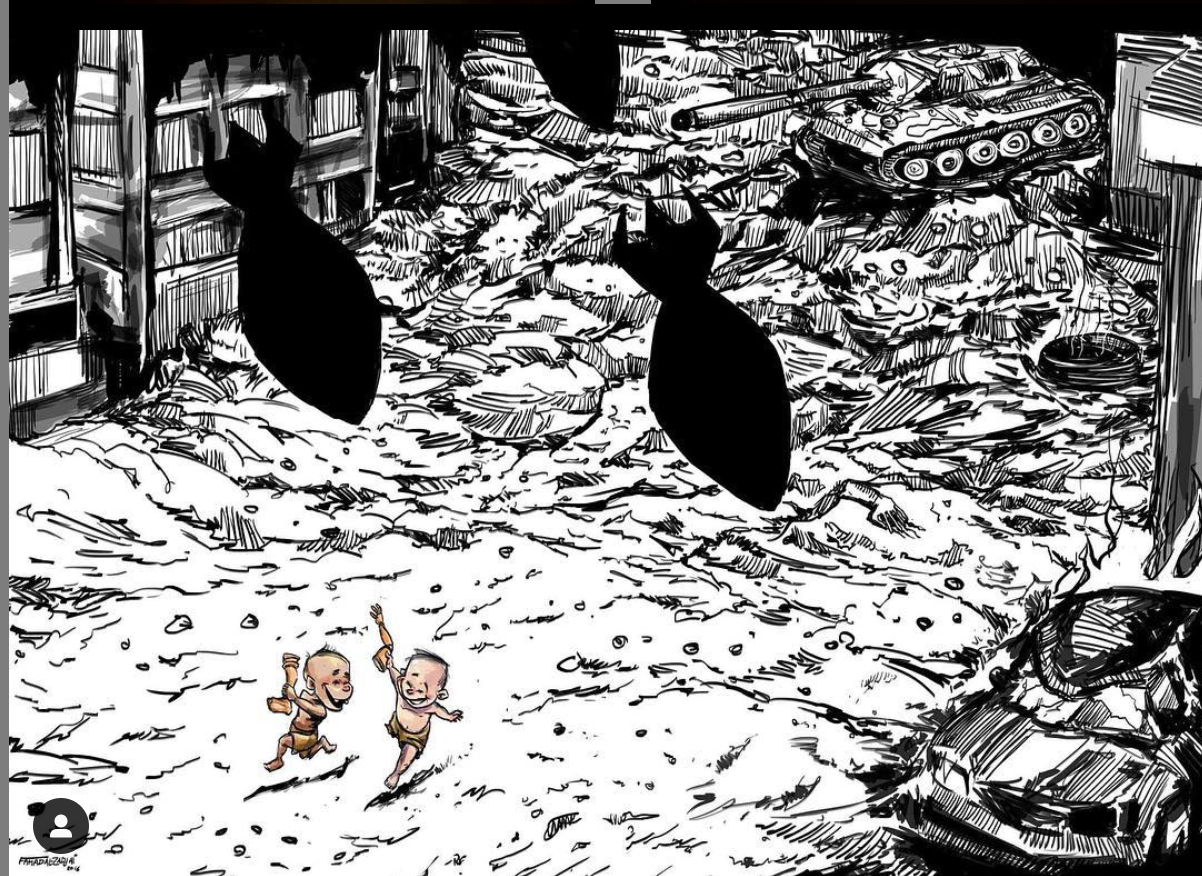
Raseef22 is a not for profit entity. Our focus is on quality journalism. Every contribution to the NasRaseef membership goes directly towards journalism production. We stand independent, not accepting corporate sponsorships, sponsored content or political funding.
Support our mission to keep Raseef22 available to all readers by clicking here!
Interested in writing with us? Check our pitch process here!
